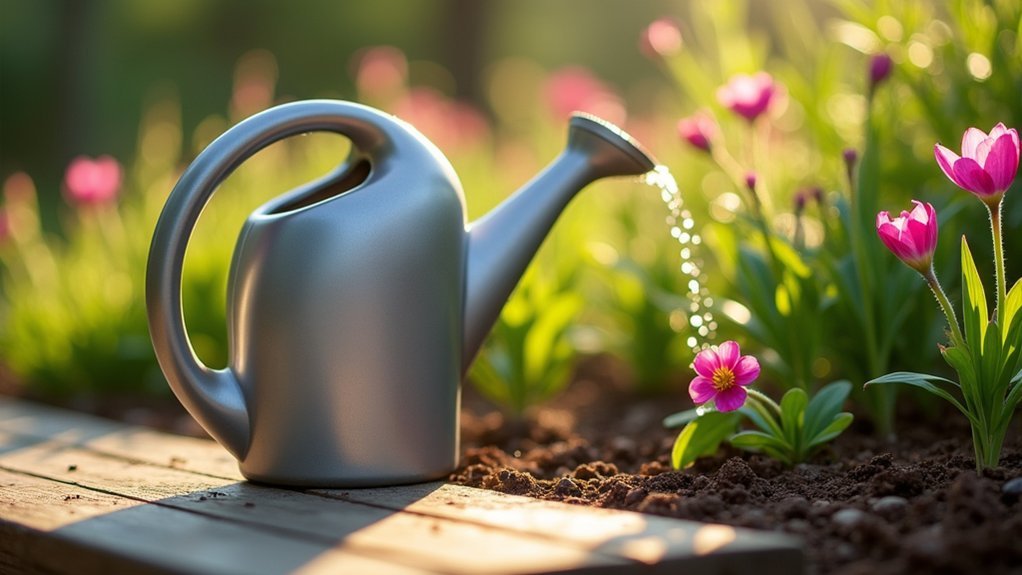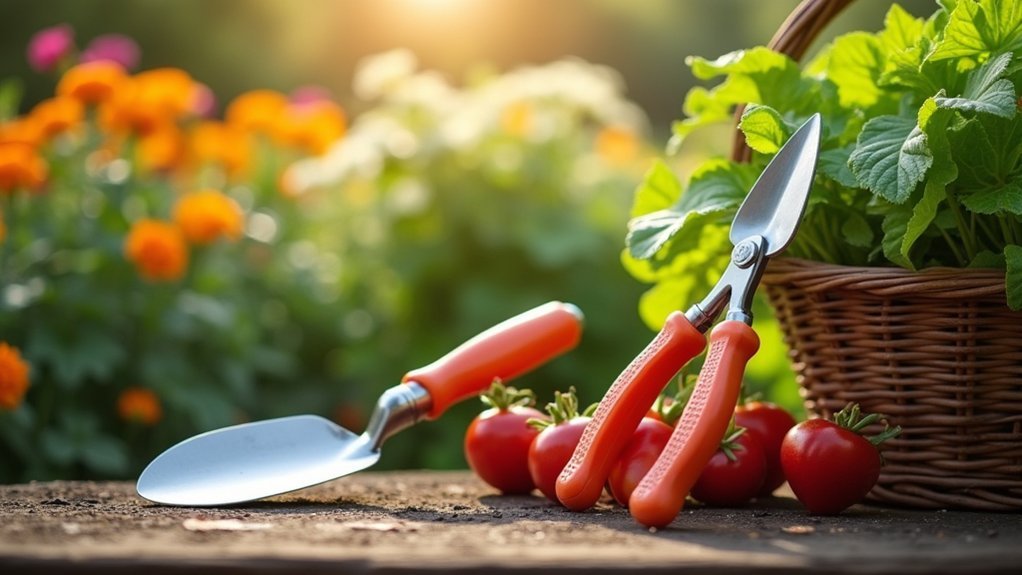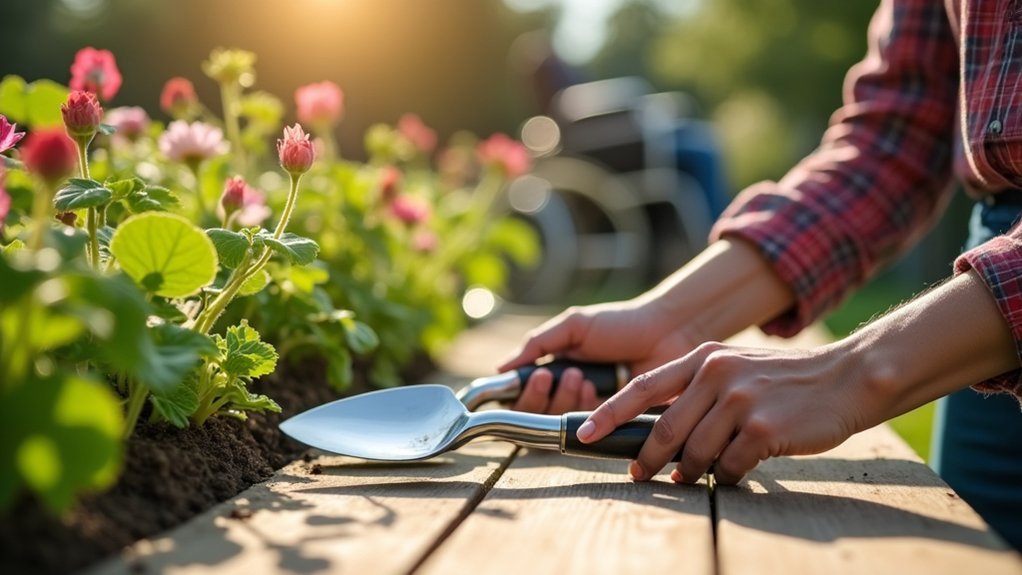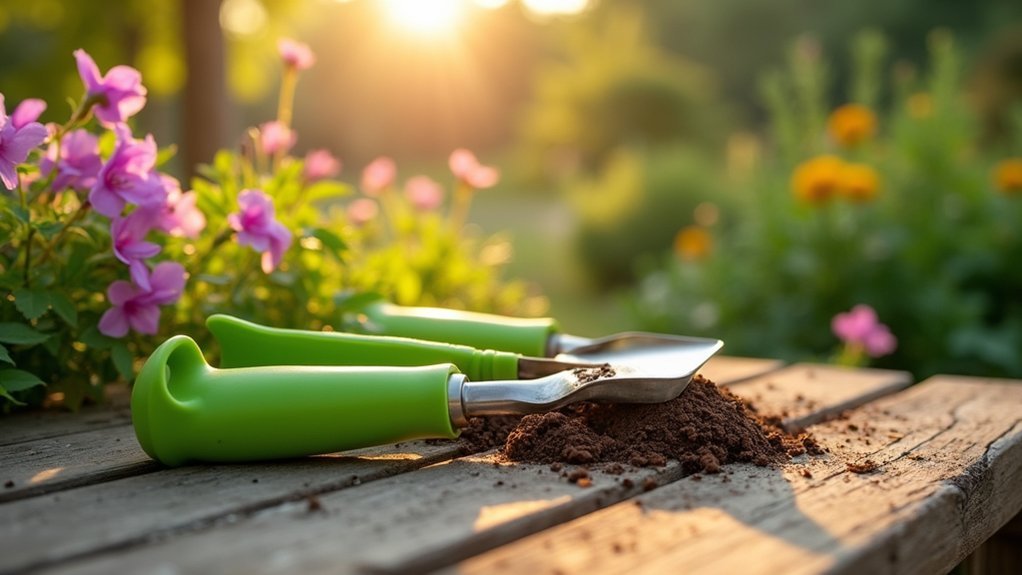After stroke recovery, you’ll benefit from specialized one-handed gardening tools with ergonomic features. Look for pruners with arm support cuffs, lightweight tools with leverage-based designs, and palm-pressure handles that distribute force evenly. Consider raised beds (28-34 inches high) or vertical gardens to minimize bending and reaching. Automatic watering systems and tool modifications like foam grips or forearm straps can greatly enhance your independence. These adaptive solutions offer both physical therapy benefits and emotional well-being.
Essential One-Handed Gardening Tools That Promote Independence

Five key tools can transform the gardening experience for stroke survivors using only one hand.
Ergonomic pruners with easy-grip handles allow you to trim plants without straining your hand. Look for models featuring arm support cuffs for additional stability and control.
Specialized pruners with supportive arm cuffs provide single-handed control for confident, precise plant trimming without fatigue.
Long-handled weeders eliminate the need to bend, reducing fatigue while efficiently removing unwanted growth.
Garden seats or stools provide comfortable positioning, minimizing physical strain during extended gardening sessions.
For planting, consider using adaptive trowels with cushioned grips and angled handles that maximize leverage with minimal effort.
Finally, invest in a tool belt or accessible storage system with high-visibility, color-coded handles so you’ll never waste energy searching for implements.
These lightweight, durable tools create meaningful independence, allowing you to enjoy gardening’s therapeutic benefits during recovery.
Ergonomic Tool Designs for Weak Grip and Limited Mobility
When recovering from a stroke, you’ll find leverage-based tools require less grip strength than traditional grip-intensive options, making gardening tasks more manageable.
Self-stabilizing handle systems with anti-slip surfaces can compensate for tremors and weakness by providing better control without extra effort.
Palm-pressure designs distribute force across your entire hand rather than concentrating it in your fingers, allowing you to garden effectively even with limited dexterity.
Research suggests that incorporating these specialized tools into rehabilitation can significantly improve quality of life for stroke patients by enhancing their ability to participate in meaningful occupational activities.
Leverage vs. Grip Tools
Understanding the difference between leverage and grip tools can greatly impact your stroke recovery gardening experience.
Leverage tools, like ratcheting pruners and lever action shears, reduce the force needed for cutting and operate with minimal effort. They’re ideal if you have weak grip strength, though they may require more overall body strength.
In contrast, grip tools feature ergonomic, contoured handles that fit naturally in your hand. These tools offer better control and precision, especially when equipped with non-slip coatings or cushioned handles to absorb shock. Many are made from lightweight materials to further reduce strain. Using these specially designed gardening tools promotes emotional well-being while providing a fulfilling activity during your recovery journey.
When selecting tools, consider your specific limitations. If you struggle with grip strength, prioritize leverage tools. If precision is your challenge but your grip remains functional, ergonomic grip tools might serve you better.
Self-Stabilizing Handle Systems
Self-stabilizing handle systems take adaptive gardening tools to the next level for stroke survivors with weak grip strength or limited mobility.
These innovative designs feature safety locks that secure tools firmly to handles, preventing accidental drops while you’re working.
You’ll find these systems incorporate anti-slip surfaces and cushioning materials that reduce vibration and minimize the force needed to maintain control.
Many models feature adjustable arm rests that support weakened limbs during extended use.
The ergonomic grip designs are contoured specifically for one-handed operation, with weight distributed to prevent fatigue even during longer gardening sessions.
Similar to the bag handle attachments available for carrying items without handles, these self-stabilizing tools provide secure grips for safer gardening experiences.
As part of your recovery program, these self-stabilizing tools can greatly boost your confidence by allowing you to garden independently again, complementing your physical therapy with practical, enjoyable activity.
Palm-Pressure Design Features
Palm-pressure design features represent a breakthrough for stroke survivors who struggle with traditional gardening tools. These designs distribute pressure evenly across your palm, reducing strain on weakened fingers and wrists.
The contoured handles cradle your hand naturally, while optimized grip angles minimize forearm fatigue. You’ll notice textured materials provide essential tactile feedback, helping you maintain a secure hold without excessive gripping force. These tools are particularly valuable for improving fine motor skills during rehabilitation, as Nicholas discovered in his recovery journey.
Tools with ergonomic balance require less arm movement, allowing you to garden longer with reduced fatigue. Many models feature cushioned grips that protect sensitive hands during extended use.
For personalized comfort, look for tools with adjustable settings that accommodate your specific strength level. These thoughtful design elements work together to transform gardening from a frustrating challenge into an enjoyable part of your recovery journey.
Raised Bed Systems and Vertical Gardens for Wheelchair Access
You’ll find wheelchair-friendly raised bed systems with heights between 28-34 inches and recessed areas allow you to roll up and reach plants without straining.
These accessible designs include forward approach options with at least 27 inches of clearance underneath and widths that don’t exceed 25 inches for comfortable reach.
Vertical growing solutions complement these systems, letting you garden upward instead of outward, which maximizes your accessible planting space while minimizing the need to stretch or move around. For optimal accessibility, consider incorporating logical design orientation in your garden layout to enhance both usability and enjoyment for those with limited mobility.
Wheelchair-Friendly Raised Designs
When recovering from a stroke while using a wheelchair, garden access shouldn’t be a barrier to enjoying the therapeutic benefits of gardening. Wheelchair-friendly raised beds can transform your gardening experience with thoughtful design considerations.
Aim for beds that are 24 inches high—perfect for seated access—with widths of 3-4 feet to guarantee you can reach all plants comfortably. Surrounding pathways should be at least 4 feet wide and made of firm, slip-resistant materials for safe navigation.
These accessible designs encourage your participation while supporting rehabilitation. They’re typically constructed with pressure-treated wood for durability against weather damage and can include bench seating for times when you might prefer to sit differently.
For maximum effectiveness, place your raised beds in permanent locations with all areas accessible from a seated position, creating a garden space that promotes independence and enhances your recovery journey.
Vertical Growing Solutions
Vertical growing solutions offer a revolutionary approach to gardening for stroke survivors with limited mobility. You’ll find these systems reduce physical strain while maximizing your planting space. Vertical gardens eliminate bending and reaching, making them ideal if you’re using a wheelchair or have one-handed limitations following a stroke. Creating an inclusive atmosphere that welcomes individuals regardless of ability level is essential for successful gardening experiences.
| System Type | Height | Width | Benefits |
|---|---|---|---|
| Raised Beds | 2.5-4 ft | Under 4 ft | Wheelchair accessible |
| Wall Gardens | Customizable | Variable | No bending required |
| Tiered Systems | Multi-level | 2-3 ft | Different plant zones |
| Hanging Options | Adjustable | Compact | Space-efficient |
Consider pathways around your vertical systems—they should be at least 60 inches wide with slopes under 2.5%. Smooth, hard surfaces like pavers provide stable navigation, while proper drainage prevents slipping hazards during maintenance.
Adaptive Watering Solutions for Single-Hand Operation

Watering the garden can present significant challenges for stroke survivors using only one hand, yet modern adaptive solutions have transformed this essential task from frustrating to feasible.
Automatic systems with timer or sensor-based controls guarantee your plants receive consistent moisture without daily manual watering.
Install automatic watering systems and let timers or sensors ensure your garden thrives without daily manual effort.
Consider installing drip irrigation that delivers water directly to roots, or use lightweight watering wands with ergonomic handles and adjustable nozzles for extended reach. Lightweight hoses with quick-connect features are available at garden centers to significantly reduce wrist strain during watering activities. Quick-release mechanisms and clever couplings allow you to connect and disconnect equipment effortlessly.
For tech-savvy gardeners, smart watering systems offer remote control via mobile devices or voice commands. These systems integrate moisture sensors and weather responsiveness to optimize watering schedules.
Beyond convenience, these tools reduce fatigue, enhance independence, and contribute to both physical recovery and emotional well-being.
Arm Support Devices That Enhance Gardening Capabilities
Arm support devices represent a game-changing advancement for stroke survivors who face challenges with grip strength and motor control.
These specialized cuffs attach to gardening tools like trowels and forks, transferring pressure from your hands to your forearms while improving stability during use.
You’ll find these supports particularly valuable when your reach is limited.
Zero-gravity systems like the SaeboMAS can assist with various gardening tasks by utilizing your forearm strength instead of relying on weaker hands.
Many devices feature adjustable designs that accommodate your specific needs and arm dimensions.
The beauty of these supports lies in their ability to promote independence while simultaneously strengthening weakened muscles.
These tools can significantly reduce residual disability for individuals recovering from stroke, allowing them to return to meaningful activities.
As you garden with these tools, you’re engaging in functional exercise that improves coordination through task-specific movements—turning a beloved hobby into effective rehabilitation.
Specialized Planting and Harvesting Tools for Stroke Survivors

Specialized planting and harvesting tools make a world of difference for stroke survivors continuing their gardening journey.
Look for ergonomic trowels and forks with natural radius grips that reduce wrist strain and feature serrated, reinforced aluminum blades for easier soil penetration.
You’ll benefit from lightweight harvesting tools with cushioned grips designed for one-handed operation.
Long-handled options eliminate the need to bend or kneel, preserving your balance and energy.
For reduced grip strength, choose tools with soft, over-molded handles and serrated edges that require less force. The Resilient Gardener Store offers several ergonomic weeders specifically designed for gardeners with limited hand strength.
Safety features like non-slip grips and balanced weight distribution improve control and precision while minimizing fatigue.
These thoughtfully designed tools accommodate limited dexterity while making planting and harvesting accessible and enjoyable again.
Tool Modification Techniques for Existing Garden Equipment
Rather than purchasing new equipment, you can transform your existing garden tools with simple modifications that accommodate one-handed use after stroke.
Adapt what you already own instead of buying specialty tools—simple modifications make one-handed gardening possible post-stroke.
Focus on adaptations that improve grip, stability, and ease of operation to make gardening accessible again.
Consider these practical modifications:
- Add thick foam or rubber grips to handles for easier grasping, or attach custom-made handles that fit your hand’s specific needs.
- Install wrist or forearm straps to secure tools without requiring constant grip strength.
- Mount tools on stable surfaces or use spring-loaded mechanisms to reduce the force needed for operation.
Weight distribution is essential—modify tools by adding counterweights or extending handles to create better balance, reducing strain and fatigue during your gardening sessions.
Consider adding lightweight long-handled tools to your collection as they’re particularly effective for reaching plants without straining your body.
Therapeutic Benefits of Adapted Gardening After Stroke

Beyond its reputation as a peaceful hobby, gardening serves as a powerful rehabilitation tool for stroke survivors facing one-handed limitations. When you engage in adapted gardening, you’re simultaneously working on physical strength, coordination, and balance through low-impact movements that research supports as beneficial post-stroke.
You’ll notice psychological improvements too—reduced anxiety and depression, enhanced emotional stability, and a greater sense of personal satisfaction in your recovery journey. The cognitive demands of planning and maintaining a garden stimulate your memory and problem-solving skills. Patients report that therapeutic gardening provides a soothing distraction from pain while offering purpose during rehabilitation.
Don’t underestimate the social benefits—whether you’re joining community garden projects or sharing your progress with caregivers, these interactions combat isolation and build support networks essential to your rehabilitation process.
Horticultural therapy’s structured approach can greatly improve your daily living activities and self-care capabilities.
Frequently Asked Questions
How Do Seasonal Weather Changes Affect Adaptive Gardening Approaches?
Seasonal weather changes require you to adjust gardening timing, select resilient plants, and implement protective measures. You’ll need flexible watering strategies and adaptable tools to accommodate temperature fluctuations and unpredictable precipitation patterns throughout the year.
Can Gardening Tools Be Shared Between Caregivers and Stroke Survivors?
Yes, you can share gardening tools effectively between caregivers and survivors. Look for durable, ergonomic, and adjustable tools with safety features. This approach saves money while creating valuable learning opportunities for both parties.
What Insurance Options Cover Specialized Adaptive Gardening Equipment?
Most insurance plans don’t cover specialized adaptive gardening equipment. You’ll likely need to pay out-of-pocket unless your doctor documents it as medically necessary for your safety or rehabilitation. Medicare typically won’t cover these tools.
How Often Should Adaptive Tools Be Replaced or Maintained?
Inspect your adaptive tools monthly, clean after each use, and sharpen blades seasonally. You’ll need to replace handles when worn, blades when dull, and electronic components when malfunctioning. Always check tools before gardening sessions.
Are Community Gardens Typically Equipped With Adaptive Gardening Resources?
Community gardens typically offer basic accessibility features like raised beds or seating, but you’ll find specialized adaptive resources less common. They’re usually designed for general inclusivity rather than providing specific tools for individualized needs.
In Summary
You’ve now discovered powerful tools that’ll transform your gardening experience during stroke recovery. With these one-handed adaptations, you’ll regain independence and confidence while enjoying therapeutic benefits. Don’t let limited mobility stop you from connecting with nature—embrace these specialized tools and modifications to make gardening accessible again. You’re not just growing plants; you’re cultivating healing, strength, and renewed purpose in your recovery journey.





Leave a Reply